Title 32
SECTION 273.8
273.8 Donations, loans, and exchanges.
§ 273.8 Donations, loans, and exchanges.(a) Authority and scope - (1) FMR. Provisions for donation of surplus personal property are provided in accordance with 41 CFR part 102-37.
(2) Other regulations. (i) 10 U.S.C. 2576a permits the Secretary of Defense to transfer certain property for use for State and local law enforcement agencies. Notwithstanding 41 CFR chapters 101 and 102, donations may be made only as authorized by law; under separate statutes, the Secretaries of the Military Departments may donate certain excess materiel to authorized recipients; through GSA, the Department of Defense may donate surplus property to authorized donees. Donations are subordinate to federal agency needs, but take precedence over sale or A/D. This section also contains guidance and procedures pertaining to loans or exchanges, providing specific instructions to authorized donees.
(ii) 42 U.S.C. chapter 68 authorizes federal assistance to States, local government, and relief organizations based on a declaration of emergency or major disaster.
(iii) 10 U.S.C. 2557, 2572, 2576, and 5576a establishes the procedures for organizations participating in surplus personal property donation programs, specifically the organizations discussed in this section.
(3) Agreements. Technology transfer projects and 10 U.S.C. 2194 address educational partnership agreements.
(b) Compliance with nondiscrimination statutes requirements. (1) All of the donation programs covered by this section must comply with:
(i) 42 U.S.C. 2000a, also known as Title VI of the Civil Rights Act of 1964.
(ii) 20 U.S.C. 1681, also known as Title IX of the Education Amendments of 1972.
(iii) 29 U.S.C. 701 also known as the Rehabilitation Act of 1973.
(iv) 42 U.S.C. 6101 also known as the Age Discrimination Act of 1973.
(2) Any complaints alleging violations of these acts or inquiries concerning the applicability to the programs covered in this section will be handled by elevating issues through the appropriate chains of command and agency-to-agency dialog.
(c) Donations of surplus personal property - (1) General. (i) Surplus property is allocated by GSA considering the factors listed in 41 CFR chapters 101 and 102.
(ii) GSAXcess® is available for State agencies for surplus property (SASPs) and donees, when authorized, to search for and select property for donation. Screening is accomplished during the timeframes specified in § 273.15.
(iii) Upon allocation, GSAXcess® will generate the SF 123, “Transfer Order Surplus Personal Property” to the agency for approval and return. DoD orders for DLA Disposition Services assets with a UMMIPS Priority Designator within Issue Priority Group 1 (Priorities 01-03), and non-mission capable supply (NMCS) orders will be submitted to DLA Disposition Services as an exception. DLA Disposition Services will immediately fill these orders and notify the GSA area property officer for the Front End Data System record adjustment. Priorities 4-15 orders received during this timeframe will not be honored.
(2) Accessing GSAXcess®. GSAXcess® screening requires an access code from GSA. To learn about GSAXcess® and obtain access code information, see https://gsaxcess.gov/.
(3) Release of Government liability. On a case-by-case basis, “hold harmless” clauses to protect the United States may be used, depending on the types and quantities of property. Such provisions must be written in coordination with appropriate DoD Component legal counsel.
(4) Reporting. DLA will provide GSA a report of property transferred to non-federal recipients. The report:
(i) Will be submitted to GSA through the GSA on-line Personal Property Reporting Tool within 90 calendar days after the close of each fiscal year. The Personal Property Reporting Tool is located at https://gsa.inl.gov/property. If for any reason the report is delayed, the organization who possesses the property should contact the GSA Personal Property Asset Management (MTA), 1800 F Street NW., Washington, DC 20405, with an explanation of the delay. The report must cover personal property disposed during the fiscal year in all areas within the 50 United States, the District of Columbia, Puerto Rico, American Samoa, Guam, the Northern Mariana Islands, the Federated States of Micronesia, the Marshall Islands, Palau, and the U.S. Virgin Islands. Negative reports are required.
(ii) Must reference Interagency Report Control Number 0154-GSA-AN and contain:
(A) Name of the non-Federal recipient.
(B) Zip code of the recipient.
(C) Explanation as to the type of recipient (e.g., contractor, grantee, cooperative, Stevenson-Wydler recipient, licensee, permittee).
(D) Appropriate 2-digit FSC group.
(E) Total original acquisition cost of all personal property furnished to each recipient.
(F) Appropriate comments as necessary.
(G) IUID or UII equivalent.
(5) Donation restrictions. (i) All surplus property (including property held by working capital funds established under 10 U.S.C. 2208 or in similar funds) is available for donation to eligible recipients, in accordance with authorizing laws, except for property in the categories in paragraphs (c)(5)(i)(A) through (M) of this section:
(A) Agricultural commodities, food, and cotton or woolen goods determined from time to time by the Secretary of Agriculture to be commodities requiring special handling with respect to price support or stabilization.
(B) Controlled substances.
(C) Foreign purchased property (as identified in DoD 5105.38-M).
(D) Naval vessels of the following categories: battleships, cruisers, aircraft carriers, destroyers, and submarines.
(E) NAF property.
(F) MLI, except in compliance with DoD Instruction 4160.28, DoD 4160.28-M Volumes 1-3, and DoD Instruction 2030.08.
(G) CCL items, except in compliance with 15 CFR parts 730 through 774 and DoD Instruction 2030.08.
(H) Property acquired with trust funds (e.g., social security trust funds).
(I) Records of the Federal Government.
(J) Vessels of 1,500 gross tons or more, excluding specified Naval combat vessels, which the Maritime Administration determines to be merchant vessels or capable of conversion to merchant use (as defined in 41 CFR chapters 101 and 102).
(K) Items as may be specified from time to time by the GSA Office of Government-wide Policy.
(L) Property that requires reimbursement upon transfer (such as abandoned or other unclaimed property that is found on premises owned or leased by the Government).
(M) Hazardous waste.
(N) Other Hazardous property and hazardous materials not otherwise identified in the categories in paragraphs (c)(5)(i)(A) through (M) of this section that is not serviceable, for example supply condition codes (SCCs) listed in DLM 4000.25-2 as SCC E for unserviceable (limited restoration) materiel, SCC F for unserviceable (reparable) materiel, and SCC G for unserviceable (incomplete) materiel, SCC H for unserviceable (condemned) materiel, SCC P for unserviceable (reclamation) materiel.
(ii) Certain items require special processing for donations (in accordance with the requirements in DoD 5105.38-M. DoD Manual 4160.21, Volume 4 provides the procedures.
(6) Returnable DoD property. (i) As restrictions are imposed on certain commodities, the Department of Defense, through GSA, will request a return of these items and provide guidance.
(ii) Known restrictions require written certification and signature by the recipient at the time of removal.
(7) Allocating surplus property. GSA directly allocates property to:
(i) FAA. Public airports are managed through the FAA.
(A) The FAA Administrator has the responsibility for selecting property determined to be either:
(1) Essential, suitable, or desirable for the development, improvement, operation, or maintenance of a public airport, as defined in 49 U.S.C. 47102.
(2) Reasonably necessary to fulfill the immediate and foreseeable future needs of the grantee for the development, improvement, operation, or maintenance of a public airport.
(3) Needed to develop sources of revenue from non-aviation businesses at a public airport.
(B) Public airports will secure advance approval of donations by obtaining signatures of the applicable FAA airport branch chief and by the GSA regional office on the order (SF 123).
(ii) United States Agency for International Development.
(iii) SASPs. (A) SASPs are responsible for determining eligibility of applicants; fairly and equitably distributing donated property to eligible donees within their State; assuring donees comply with donation terms and conditions; and when requested by donee, arranging for or providing shipment of property from the federal holding agency, e.g., DLA Disposition Services sites, directly to the recipients.
(B) The SASP donates property to public and eligible nonprofit organizations. Types of eligible recipients are:
(1) Medical institutions, hospitals, clinics, and health centers.
(2) Drug abuse and alcohol centers.
(3) Providers of assistance to homeless individuals.
(4) Providers of assistance to impoverished families and individuals.
(5) Schools, colleges, and universities.
(6) Schools for the mentally and physically disabled.
(7) Child care centers.
(8) Radio and television stations licensed by the Federal Communications Commission as educational radio or television stations.
(9) Museums attended by the public.
(10) Libraries providing the resident public (community, district, State, or region) with free access.
(11) State and local government agencies, or nonprofit organizations or institutions. 42 U.S.C. 3015 and 3020 authorizes donations of surplus property to State and local government agencies, or nonprofit organizations or institutions that receive federal funding to conduct programs for older individuals.
(12) States and territories.
(13) SEAs. The Deputy Secretary of Defense is authorized to designate new SEAs. Table 4 of this section includes the list of approved SEAs. SEA nominations from the Military Departments or Defense Agencies should be forwarded to the Office of the Assistant Secretary of Defense for Logistics and Materiel Readiness, 3500 Defense Pentagon, Washington, DC 20301-3500
(14) Educational activities that are of special interest to the Military Services may receive surplus DoD property in accordance with 41 CFR chapter 101.
Table 4 - SEA National Offices
| American National Red Cross, 17th and D Streets NW., Washington, DC 20006 | Armed Services YMCA of the USA, 6225 Brandon Avenue, Suite 215, Springfield, VA 22150-2510. |
| Big Brothers/Big Sisters of America, 230 North 13th Street, Philadelphia, PA 19107 | Boys and Girls Clubs of America, 771 First Avenue, New York, NY 10017. |
| Boy Scouts of America, 1325 Walnut Hill Lane, Irving, TX 75038-3096 | Camp Fire, Inc., 4601 Madison Avenue, Kansas City, MO 64112-1278. |
| The Center for Excellence In Education, 7710 Old Springhouse Road, McLean, VA 22102 | Girl Scouts of America, 420 5th Avenue, New York, NY 10018-2702. |
| Little League Baseball, Inc., Williamsport, PA 17701 | National Association for Equal Opportunity In Higher Education, 2243 Wisconsin Avenue NW., Washington, DC 20007. |
| National Ski Patrol System, Inc., 133 South Van Gordon Street, Suite 100, Lakewood, CO 80228 | U.S. Naval Sea Cadet Corps, 2300 Wilson Boulevard, Arlington, VA 22201. |
| United Service Organizations, Inc., 601 Indiana Avenue, Washington, DC 20004 | United States Olympic Committee, 1 Olympic Plaza, Colorado Springs, CO 80909-5760. |
| National Director, Young Marines of the Marine Corps, P.O. Box 70735, Southwest Station, Washington, DC 20024-0735 | President - Board of Directors, Marine Cadets of America, USN & MC Reserve Center, Fort Nathan Hale Park, New Haven, CT 06512-3694. |
| Corporation for the Promotion of Rifle Practice and Firearms Safety, Erie Industrial Park, Building 650, P.O. Box 576, Port Clinton, OH 43452 | Marine Corps League, P.O. Box 3070, Merrifield, VA 22116. |
(C) High schools that host a Junior Reserve Officer Training Corps (JROTC) Unit or a National Defense Cadet Corps Unit, Naval Honor Schools, and State Maritime Academies should contact their sponsoring Military Department regarding donations.
(D) SEAs must maintain separate records that include:
(1) Documentation verifying that the activity has been designated as eligible by the Department of Defense to receive surplus DoD property.
(2) A statement designating one or more donee representatives to act for the SEA in acquiring property.
(3) A listing of the types of property that are needed or have been authorized by the Department of Defense for use in the SEA program.
(8) Identification of screeners. (i) SASP personnel or donee personnel representing a SASP must have a valid screener-identification card (GSA Optional Form 92, screener's identification, or other suitable identification approved by GSA) before screening and selecting property at holding agencies. However, SASP or donee personnel do not need a screener ID card to inspect or remove property previously set aside or approved by GSA for transfer.
(ii) Screeners, having identified themselves and indicated the purpose of their visit, will sign the Visitor or Vehicle Register and be allowed to complete donation screening only.
(9) Screening and ordering procedures for DLA Disposition Services property. (i) Section 273.15(c) outlines the screening timeframes for ZI surplus and FEPP that has reached the surplus release date.
(ii) When a prospective donee contacts a DLA Disposition Services site or military installation regarding possible acquisition of surplus property, the individual or organization will be advised to contact the applicable SASP for determination of eligibility and procedures to be followed. The DLA Disposition Services sites will assist interested parties regarding availability of surplus property.
(iii) SASP contacts may be located on the GSA Web site at http://www.gsa.gov/portal/content/100851.
(iv) Prospective donees must go to GSAXcess® to gain access, shop, and select property.
(A) Once GSA allocates property, the SASP will receive an SF 123. The donee should then sign and return the SF 123 to the appropriate GSA office.
(B) GSA will then approve the SF 123 by signature, return the SF 123 to the SASP, and notify DLA Disposition Services with an electronic order.
(v) Procedures for return of surplus FEPP to the United States for ultimate donation are covered in Enclosure 4 of DoD Manual 4160.21, Volume 2.
(vi) DLA Disposition Services sites will require recipients of HM to sign a certification statement as shown in Figure 2 of this section.
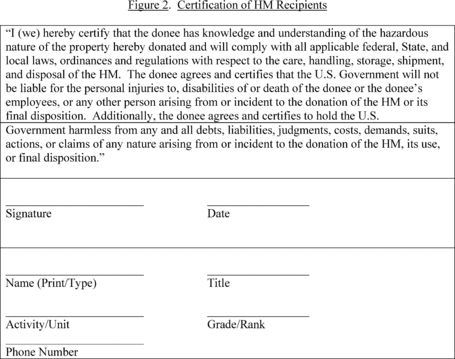
(A) After allocation and approval, if the customer no longer wants or needs the property, the customer is required to notify the SASP, GSA, and the DLA Disposition Services site.
(B) GSA may reallocate the property if there is an existing request by another potential recipient. If the property is reallocated, cancellation of the existing request will be transmitted by GSA and another transmission to DLA Disposition Services is required.
(C) If the property is not reallocated, GSA must cancel the existing MRO.
(10) Customer removal of ordered property. (i) All transportation arrangements and costs are the responsibility of the SASP or designated donee. The DLA Disposition Services site may not act as agent packager or shipper. Until release, each holding activity is responsible for the care and handling of its property.
(ii) The SASP or designated donee will only pay for direct costs of care and handling incurred in the actual packing, crating, preparation for shipment, and loading. The price will be the actual or carefully estimated costs incurred by DoD traffic management activities for labor, material, or services used in donating the property.
(iii) Advance payment for care and handling costs will normally be required; however, State and local governmental units may be exempted from this requirement and authorized to make payment within 60 days from date of receipt of property. Advance payment may be required in any case where prompt payment after billing has been unsatisfactory.
(iv) Donees must schedule removal of property with the DLA Disposition Services site. Upon arrival, the individual must provide identification and must sign the DLA Disposition Services Visitor or Vehicle Register, indicating the purpose of the visit.
(v) The individual must provide an approved SF123 as authorization for removal.
(vi) DLA Disposition Services sites will release surplus property to authorized donees upon receipt of a properly completed and approved SF 123 or MRO.
(d) Special donations (gifts), loans, and exchanges outside the FMR - (1) Compliance. The DoD Components:
(i) Comply with the specific governing statute for the type of property and ensure the limitations of the governing statute are observed. In accordance with 10 U.S.C. 2572 and DoD issuances, the Secretary of a Military Department or the Secretary of the Treasury is permitted to donate, lend, or exchange, as applicable, without expense to the United States, books, manuscripts, works of art, historical artifacts, drawings, plans, models and condemned or obsolete combat materiel that are not needed by the Military Services.
(ii) Establish supplementary procedures governing loans, donations, and exchanges.
(iii) May donate, loan or exchange items as identified in paragraph (d)(1) of this section, if the special donation, loan, or exchange action occurs prior to transfer to DLA Disposition Services for disposition. It is not authorized after property has been officially declared excess and transferred to DLA Disposition Services.
(iv) May exchange assets for:
(A) Similar items;
(B) Conservation supplies, equipment, facilities, or systems;
(C) Search, salvage, or transportation services;
(D) Restoration, conservation or preservation services; or
(E) Educational programs when it directly benefits the historical collection of the DoD Components.
(v) May not make an exchange unless the monetary value of the property transferred or services provided to the United States under the exchange is not less than the value of the property transferred by the United States. The Secretary concerned may waive this limitation in the case of an exchange for property in which the Secretary determines the item to be received by the United States will significantly enhance the historical collection of the property administered by the Secretary.
(vi) Will not incur costs in connection with loans or gifts. However, the DoD Component concerned may, without cost to the recipient, DEMIL, prepare, and transport within the CONUS items authorized for donation to a recognized war veterans' association in accordance with DoD 4160.28-M Volumes 1-3 if the DoD Component determines this can be accomplished as a training mission, without additional expenditures for the unit involved.
(vii) Will maintain official records of all DoD materiel loaned including physical inventory, record reconciliation, and management reporting specified in the inventory management procedures in DoD Manual 4140.01, “DoD Supply Chain Materiel Management Procedures” (available at http://www.dtic.mil/whs/directives/corres/pdf/414001m/414001m_vol01.pdf). Verify yearly that property is being used for approved purposes, is being maintained and protected according to the agreement, and that the recipient organization still desires to retain the property. The DoD Component may perform this annual check by any method that provides reasonable assurance the recipient organization is fulfilling its responsibilities. DoD Components may request assistance from qualified DoD organizations.
(2) Organizations authorized to receive loans and donations. (i) A municipal corporation.
(ii) A soldiers' monument association.
(iii) An incorporated museum or memorial that is operated by a historical society, a historical institution of a State or foreign nation, or a nonprofit military aviation heritage foundation or association incorporated in a State.
(iv) An incorporated museum that is operated and maintained for educational purposes only and the charter of which denies it the right to operate for profit.
(v) A post of the Veterans of Foreign Wars of the United States or the American Legion or a unit of any other recognized war veterans' association.
(vi) A local or national unit of any war veterans' association of a foreign nation recognized by the national government of that nation (or by the government of one of the principal political subdivisions of that nation).
(vii) A post of the Sons of Veterans Reserve.
(3) Requirements for veterans' organizations. To qualify, veterans' organizations must be:
(i) Sponsored by a Military Department.
(ii) Evaluated based on its size, purpose, the type and scope of services it renders to veterans, and composed of honorably discharged American soldiers, sailors, airmen, marines, or coastguardsmen.
(4) Requirements for museums. To qualify, museums must:
(i) Meet State (or equivalent foreign national) criteria for not-for-profit museums.
(ii) Have an existing facility suitable for the display and protection of the type of property desired for loan or donation. If the requester has a facility under construction that will meet those requirements, interim eligibility may be granted.
(iii) Have a professional staff that can care for and accept responsibility for the loaned or donated property.
(iv) Have assets that, in the determination of the loaning or donating service, indicate the capability of the loaner and the borrower to provide the required care and security of historical property.
(5) Eligibility determination. The DoD Components will determine the eligibility of organizations for gifts and loans. The DoD Components may establish eligibility requirements dependent upon the unique nature of the specific historical item; however, the minimum requirements are:
(i) Limit donations, loans, or exchanges to property stipulated by 10 U.S.C. 2557, 2572, 2576, and 2576a. Except for relevant records for aircraft and associated engines and equipment (unless authorized under DoD 4160.28-M Volumes 1-3 and DoD Instruction 2030.08), government records may not be released.
(ii) Approve the loan, donation, or exchange; process requests for variations from the original agreement; and maintain official records of all donation, loan, and exchange agreements. The approval of exchanges may be delegated at the discretion of the Secretary concerned, and is encouraged for low-dollar transactions.
(iii) Establish controls for determining compliance by the recipient organization with the display, security, and usage criteria provided in the loan and donation agreements.
(iv) Provide disposition instructions to the recipient organization when loaned or donated property is no longer needed or authorized for continued use.
(v) Establish conditions for making donations, loans, or exchanges.
(vi) Establish a process (e.g., a council or other means suitable to the loan and donation organization) to review and approve proposed exchanges incorporating legal and financial review independent of the museum involved. Personnel directly involved in museum operations will not act as sole approving authority for any exchange transactions.
(vii) Ensure that correspondence regarding loans, donations, or exchanges is signed by individuals authorized to obligate their organization.
(viii) Ensure appropriate DEMIL of the property as prescribed in DoD 4160.28-M Volumes 1-3 before release. If standard DEMIL criteria cannot be applied without destroying the display value, specific DEMIL actions (such as aircraft structural cuts) may be delayed. The recipient organization must agree to assume responsibility for the property DEMIL action, at no cost to the Government, when the item is no longer desired or authorized for display purposes. The recipient organization may also return the property to the Government via the donating Military Department for full DEMIL action.
(ix) Loan, donate, or exchange property on an “as is, where is” basis and ensure that the recipient organization agrees to pay all costs incident to preparation, handling, and movement of the property. Military Department contact points for the loan, donation, or exchange of property are at Table 5 of this section.
(A) Property may not be repaired, modified, or changed at government expense over and above normal preparation for handling and movement, even if reimbursement is offered for services rendered.
(B) Property may not be moved at government expense to a recipient's location or to another location closer to the recipient to prevent or lessen the recipient organization's processing or transportation costs.
(C) No charge will be made for the property itself, but all physical processing of the property for the loan or donation will be the responsibility of the recipient organization. The recipient organization will pay all applicable charges before release of the property.
Table 5 - Military Department Contact Points for Loan, Donation, or Exchange of Property
| ARMY: (all commodities) |
| Commander |
| U.S. Army Tank Automotive and Armament Command |
| ATTN: AMSTA-IM-OER |
| Warren, MI 48397-5000 |
| Email: [email protected] |
| Telephone: 1-800-325-2920 extension 48469 |
| NAVY: |
| Navy and Marine Corps aircraft, air launched missiles, aircraft engines, and aviation related property: |
| Commanding Officer |
| NAVSUP Weapon Systems Support |
| ATTN: Code-03432-06 |
| 700 Robbins Ave. |
| Philadelphia, PA 19111-5098 |
| Obsolete or condemned Navy vessels for donation as memorials; Navy major caliber guns and ordnance; and shipboard materiel: |
| Commander |
| ATTN: NAVSEA-OOD, NC |
| Naval Sea Systems Command |
| 2531 Jefferson Davis Highway |
| Arlington, VA 22242-5160 |
| AIR FORCE: |
| Air Force aircraft, missiles or any other items authorized for donation for display purposes to a museum recipient: |
| NMUSAF/MUX |
| 1100 Spaatz St. |
| Wright-Patterson AFB, OH 45433-7102 |
| The USAF Museum operates a loan program only. Donations are not offered. |
| Any other Air Force item authorized for donation for display purposes (to recipients other than a museum): |
| HQ AFMC/A4RM |
| 4375 Chidlaw Rd., Building 262 |
| Wright-Patterson AFB, OH 45433-5006 |
| MARINE CORPS: |
| Marine Corps assault amphibian vehicles (to recipients other than a museum): |
| Commandant of the Marine Corps |
| ATTN: LPC-2 |
| HQ U.S. Marine Corps |
| 3000 Marine Corps, Pentagon, RM 2E211 |
| Washington, DC 20350 |
| Marine Corps historical property (all other inquiries): |
| Commandant of the Marine Corps |
| ATTN: History and Museum Division (HD) |
| Marine Corps Historical Center |
| 1254 Charles Morris Street SE |
| Washington Navy Yard, DC 20374-5040 |
| U.S. Coast Guard |
| For U. S. Coast Guard historical assets contact COMDT (CG-09224) at mail stop 7031: |
| Commandant (CG-09224) |
| U. S. Coast Guard Headquarters, Douglas A. Munro Building |
| 2703 Martin Luther King Jr. Ave. South East, Stop 7031 |
| Washington, DC 20593-7031 |
| For all other assets contact Commandant (CG-844) at mail stop 7618: |
| Commandant (CG-844) |
| U. S. Coast Guard Headquarters, Douglas A. Munro Building |
| 2703 Martin Luther King Jr. Avenue South East, Stop 7618 |
| Washington, DC 20593-7618 |
(x) Record assets on property accountability records before they are loaned, donated, or exchanged.
(xi) Coordinate with the DoS before a donation, loan, or exchange is formalized with a foreign museum.
(xii) Ensure an official authorized to obligate the organization signs a certificate of assurance, as shown at Figure 3 of this section.
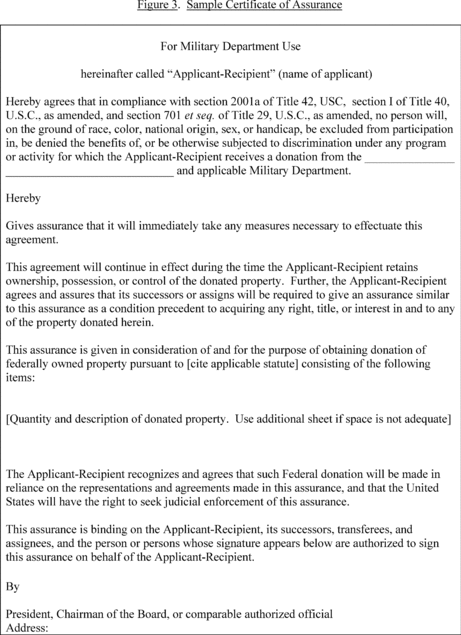
(xiii) Ensure proper documentation is finalized in accordance with DoD 4160.28-M Volumes 1-3 before the release of any property to an authorized recipient.
(A) Use the standard loan agreement in the format prescribed by Figure 4 of this section or a similar document providing the same data for accomplishing property loans.
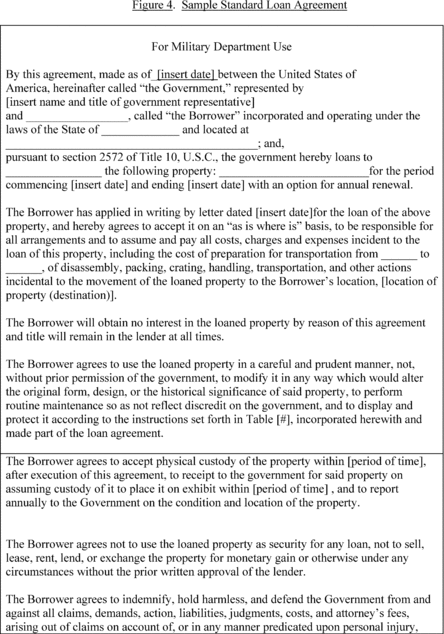
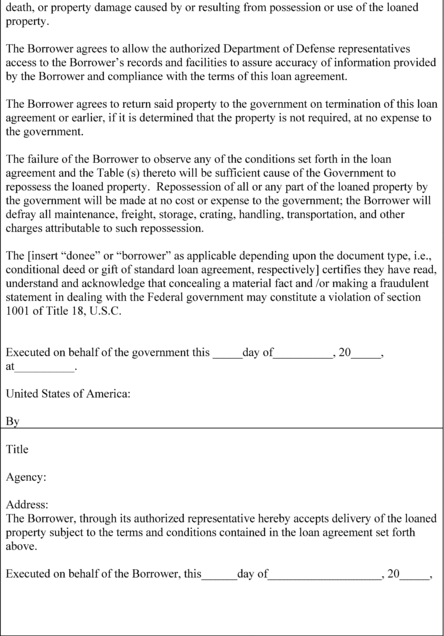

(B) Accomplish property donations made under this authority by use of the conditional deed of gift agreement in the format prescribed in Figure 5 of this section or a similar document providing the same data.
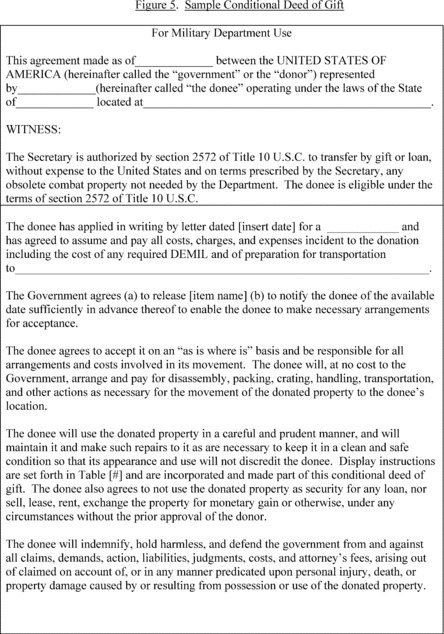
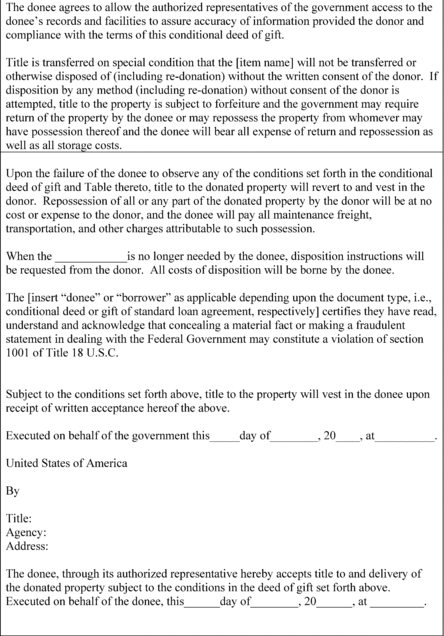

(C) Accomplish property exchanges made under this authority by use of the exchange agreement in the format prescribed in Figure 6 of this section or a similar document providing the same data. Items may not be exchanged until a determination is made that the item is not needed for operational requirements by another Military Department. If the council or similar staff review process considers it unlikely the item in question will be needed by another Military Department, screening may be omitted. A museum of one Military Department may not acquire for the purpose of exchanging historical items being screened by another Military Department museum.

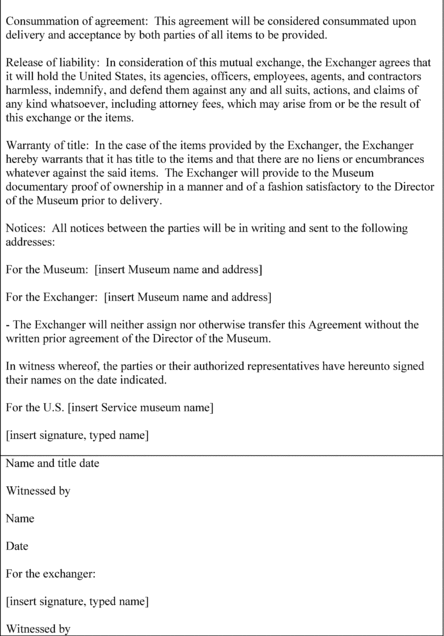
(xiv) Avoid stockpiling condemned or obsolete combat materiel in anticipation of future exchanges. Items that cannot be exchanged within a 2-year period should be processed for disposal.
(xv) Notify exchange recipients that the Department of Defense cannot certify aircraft, components, or parts as airworthy. Aircraft, components, or parts must be certified by the FAA as airworthy before being returned to flight usage. If available, logbooks and maintenance records for FSCAP must accompany the aircraft and FSCAP. If such documentation is not available, or if the aircraft or FSCAP have been crash-damaged or similarly compromised, the aircraft, components, or parts may not be exchanged, unless the FSCAP parts have been removed from the aircraft or component prior to the exchange. Waivers to this FSCAP documentation requirement may be considered on a case-by-case basis and are restricted to “display only” property (not parts); waivers will apply only to the exchange of the whole aircraft, aircraft engines, and aircraft components. The exchange agreement must explicitly cite the lack of documentation.
(xvi) Consider any adverse market impact that may result from the exchange of certain items. The Military Department should consult with outside organizations for market impact advice, as appropriate.
(xvii) Elect to donate property without conditions; for example, when the administrative costs to the Military Department to perform yearly checks would exceed the value of the property. Unconditional donations are restricted to books, manuscripts, works of art, drawings, plans and models, and historical artifacts valued at less than $10,000 that do not require DEMIL (see Figure 7 of this section).
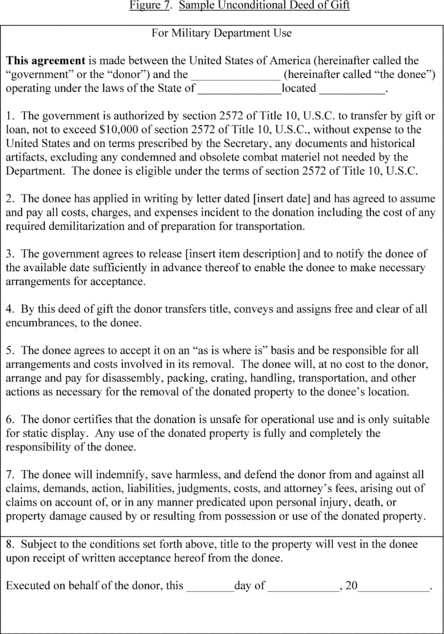
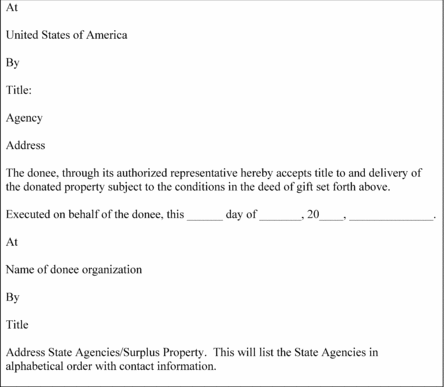
(6) Military departments loans of bedding. Consistent with 10 U.S.C. 2557, the Secretary of a Military Department may provide bedding in support of homeless shelters that are operated by entities other than the Department of Defense. Bedding may be provided to the extent that the Secretary determines the donation will not interfere with military requirements.
(7) Army loans to veterans' organizations. (i) The Department of the Army, in accordance with 10 U.S.C. 4683, may loan to recognized veterans' organizations (or local units of national veterans' organizations recognized by the U.S. Department of Veterans Affairs) obsolete or condemned rifles or cartridge belts for use by that unit for ceremonial purposes. Rifle loans to any one post, local unit, or municipality are limited by statute to not more than 10 rifles.
(ii) The Secretary of the Army, in accordance with 10 U.S.C. 4683 and Service-unique regulations prescribed by the Secretary, may conditionally lend or donate excess M-1 rifles (not more than 15), slings, and cartridge belts to any eligible organization for use by that organization for funeral ceremonies of a member or former member of the Military Services, and for other ceremonial purposes. If the loaned or donated properties under paragraph (d)(8)(i) of this section are to be used by the eligible organizations for funeral ceremonies of a member or former member of the Military Services, the Secretary may issue and deliver the rifles, together with the necessary accoutrements and blank ammunition, without charge.
(8) Navy loans and donations. (i) The Secretary of the Navy, in accordance with 10 U.S.C. 7545, may donate or loan captured, condemned, or obsolete ordnance materiel, books, manuscripts, works of art, drawings, plans, models, trophies and flags, and other condemned or obsolete materiel, as well as materiel of historical interest. The Secretary of the Navy may donate this material to any State, territory, commonwealth, or possession of the United States and political subdivision or municipal corporation thereof, the District of Columbia, libraries, historical societies, and educational institutions whose graduates or students were in World War I or World War II.
(A) Loans and donations made under this authority will be subject to the same guidelines for donations in accordance with 10 U.S.C. 2572.
(B) If materiel to be loaned or donated is of historic interest, the application will be forwarded through the Navy Curator.
(C) Donations made under this authority must first be referred to the Congress.
(D) Donations and loans made under 10 U.S.C. 7545 will be made with a conditional deed of gift (see Figure 5 of this section for sample wording).
(ii) In accordance with 10 U.S.C. 7306, the Secretary of the Navy, with approval of Congress, may donate obsolete, condemned, or captured Navy ships, boats, and small landing craft to the States, territories, or possessions of the United States, and political subdivisions or municipal corporations thereof, the District of Columbia, or to associations or corporations whose charter or articles of agreement denies them the right to operate for profit. The Navy restricts the use of donated vessels for use in static display purposes only (i.e., as memorials or museums).
(A) Applications for ships, boats, and small landing craft will be submitted to the Commander, Naval Sea Systems Command (NSEA 00DG), 2531 Jefferson Davis Highway, Arlington, VA 22240-5160.
(B) Before submission of an application, the applicant must locate obsolete, condemned, or captured Navy ships, boats, and small landing craft which are available for transfer.
(iii) Each application will contain:
(A) Type of vessel desired, or in the case of combatant vessels, the official Navy identification of the vessel desired.
(B) Statement of the proposed use to be made of the vessel and where it will be located.
(C) Statement describing and confirming availability of a berthing site and the facilities and personnel to maintain the vessel.
(D) Statement that the applicant agrees to maintain the vessel, at its own expense, in a condition satisfactory to the Department of the Navy, in accordance with instructions that the Department may issue, and that no expense will result to the United States as a consequence of such terms and conditions prescribed by the Department of the Navy.
(E) Statement that the applicant agrees to take delivery of the vessel “as is, where is” at its berthing site and to pay all charges incident to such delivery, including without limitation preparation of the vessel for removal or tow, towing, insurance, and berthing or other installation at the applicant's site.
(F) Statement of financial resources currently available to the applicant to pay the costs required to be assumed by a donee. The statement should include a summary of sources, annual income, and annual expenditures exclusive of the estimated costs attributable to the requested vessel to permit an evaluation of funds available for upkeep of the vessel. In the event the applicant will rely on commitments of donated services and materials for maintenance and use of the vessel, such commitments must be described in detail.
(G) Statement that the applicant agrees that it will return the vessel, if and when requested to do so by the Department of the Navy, during a national emergency, and will not, without the written consent of the Department, use the vessel other than as stated in the application or destroy, transfer, or otherwise dispose of the vessel.
(H) If the applicant asserts it is a corporation or association whose charter or articles of agreement denies it the right to operate for profit, their application must also contain a copy of the organization's bylaws and either:
(1) A properly authenticated copy of the charter.
(2) Certificate of incorporation.
(3) Articles of agreement made either by:
(i) The Secretary of State or other appropriate officials of the State under the laws where the applicant is incorporated.
(ii) Organized or other appropriate public official having custody of such charter, certificate or articles.
(I) If the applicant is not incorporated, their application must also include the citation of the law and a certified copy of the association's charter stating it is empowered to hold property and to be bound by the acts of the proposed signatories to the donation agreement.
(J) If the applicant is not a State, territory, or possession of the United States, a political subdivision or municipal corporation thereof, or the District of Columbia, the application must also include a copy of a determination by the Internal Revenue Service that the applicant is exempt from tax under the Internal Revenue Code.
(K) A notarized copy of the resolution or other action of its governing board or membership authorizing the person signing the application to represent the organization and to sign on its behalf to acquire a vessel.
(L) A signed copy of the assurance of compliance.
(M) A statement that the vessel will be used as a static display only as a memorial or museum and no system aboard the vessel will be activated or permitted to be activated for the purpose of navigation or movement under its own power.
(N) A statement that the galley will not be activated for serving meals.
(iv) Upon receipt, the Navy will determine the eligibility of the applicant to receive a vessel by donation. If eligible, the formal application will be processed and notice of intention to donate presented to the Congress as required by 10 U.S.C. 7306, provided the applicant has presented evidence satisfactory to the government that the applicant has adequate financial means to accomplish all of the obligations required under a donation contract. The Navy will have authority to donate only after the application has been before the Congress for a period of 60 days of continuous session without adverse action by the Congress in accordance with 10 U.S.C. 7306.
(v) All vessels, boats, and service craft, donated in accordance with 10 U.S.C. 7306, will be used as static displays only for use as memorials and cannot be activated for the purpose of navigation or movement under its own power. Donations of vessels under any other authority of this section are subject to certain inspection and certification requirements. Applicants for vessels or service craft will be advised in writing by the office taking action on the applications that, should their request be approved and before operation of the vessel or service craft, one of the following stipulations will apply:
(A) The donee agrees that if the vessel is 65 feet in length or less, it may not be operated without a valid certificate of inspection issued by the U.S. Coast Guard, while carrying more than six passengers, as defined in 46 U.S.C. 2101(21)(B).
(B) The donee agrees that if the vessel is more than 65 feet in length, it may not be operated without a valid certificate of inspection issued by the U.S. Coast Guard.
(vi) In accordance with 10 U.S.C. 7546 and subject to the approval of the Navy Museum Curator, the nameplate or any small article of a negligible or sentimental value from a ship may be loaned or donated to any individual who sponsored that ship provided that such loan or donation will be at no expense to the Navy.
(9) Donation of excess chapel property. In accordance with 10 U.S.C. 2580, the Secretary of a Military Department may donate excess personal property to religious organizations (as described in 26 U.S.C. 501), for the purposes of assisting such organizations in restoring or replacing property of the organization that has been damaged or destroyed as a result of arson or terrorism. The property authorized for donation will be limited to ecclesiastical equipment, furnishings and supplies that fall within FSC 9925, and furniture.
(10) Disposition after use of special donations (gifts), loans, and exchanges. (i) The requirements of the recipient organization are:
(A) For materiel no longer desired or authorized for continued use by a recipient organization, the Military Department will advise the recipient organization if it wants to repossess the property. Regardless of the determination made, care will be taken to ensure the recipient organization fulfills its responsibility to finalize the disposition action at no cost to the government. Repossession of the property will be governed by the property's historical significance, its potential for use in behalf of other requests, or its estimated sale value, if sold by the Department of Defense. Repossession of property will be documented; copies of the documentation will be retained by the donee and lender.
(B) Based on type of property, its location, etc., it is not always feasible to require the physical movement of the property to the nearest DLA Disposition Services site. In these cases, the owning Military Department may elect to work with DLA Disposition Services for receipt and sale in-place, when economically feasible.
(ii) Return of property donated to the Navy is subject to the approval of the Curator for the Department of the Navy. Any article, materiel, or equipment, including silver service, loaned or donated to the naval service by any State, group, or organization may be returned to the lender or donee in accordance with 10 U.S.C. 7546. When the owner cannot be located after a reasonable search, or if, after being offered the property, the owner states in writing that the return of the property is not desired, the property will be disposed of in the same manner as other surplus property.
(e) Disaster assistance for States. 42 U.S.C. chapter 68 allows for disaster assistance to States.
(1) 42 U.S.C. chapter 68, also known and referred to in this rule as “The Stafford Act” authorizes federal assistance to States, local governments, and relief organizations. Upon declaration by the President of an emergency or a major disaster, under, the Stafford Act, the State receiving the declaration is notified immediately and a notice of the declaration is published in the Federal Register by the Federal Emergency Management Agency (FEMA).
(2) Excess personal property may be loaned to State and local governments for use or distribution for emergency or major disaster assistance purposes. Such uses may include the restoration of public facilities that have been damaged as well as the essential rehabilitation of individuals in need of major disaster assistance. The availability of Federal assistance under the Stafford Act is subject to the time periods prescribed in FEMA regulations.
(f) Academic institutions and non-profit organizations. Educational partnership (or other) agreements may be established for the loan or donation of property.
(1) Under an educational partnership (or other) agreement, and consistent with 10 U.S.C. 2194, the Secretary of Defense authorized the director of each defense laboratory to enter into one or more educational partnership agreements with U.S. educational institutions for the purpose of encouraging and enhancing study in scientific disciplines at all levels of education. The educational institutions will be local educational agencies, colleges, universities, and any other nonprofit institutions that are dedicated to improving science, mathematics, and engineering education. The point of contact is the DoD Technology Transfer Program Manager, Suite 1401 Two Skyline Place, 5203 Leesburg Pike, Falls Church, VA 22041-3466.
(2) In accordance with 15 U.S.C. 3710(i), the director of a DoD laboratory may directly transfer (donate) laboratory (e.g., scientific, research) equipment that is excess to the needs of that laboratory to public and private schools and nonprofit institutions in the U.S. zone of interior (ZI).
(3) Determinations of property suitable for donation will be made by the head of the laboratory. Property will be screened within the DoD laboratory and scientific community prior to release.
(4) Laboratories should be aware that some property might be environmentally regulated and, if exported, may require a U.S. DoS or Commerce export license, including certain circumstances where exports to foreign parties take place in the U.S. Moreover, some property may require DEMIL. Standard eligibility criteria must be ensured and a screening process for determining trade and security control risk are mandatory.